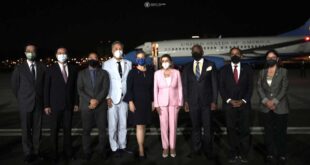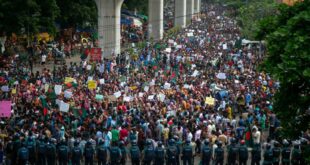Giancarlo Elia Valori
It is not so obvious we can define – sic et simpliciter – the recent Summit held in Hanoi between the leader of the Democratic People’s Republic of Korea, Kim Jong-Un, and the US President, Donald J. Trump, as a mere and insignificant “failure”.
Or – according to the most simplistic international press comments – even as a failure of Trump’s techniques as a deal maker.
It is not an issue of popular psychology. Here the issue is of a geoeconomic and strategic nature.
Also the North Korean leader, Kim Jong-Un, is a very talented mediator and broker but, as is currently obvious, here the issue is much broader than what it could appear at first glance.
It was the North Korean Foreign Minister, Ri-Yung-Ho, however, who announced that negotiations had ended without an official agreement.
The initial idea of the North Korean leaders was to immediately lift some of the remaining economic sanctions on the Democratic People’s Republic of Korea and later proceed to the total dismantling of the great Yongbyon reactor.
After this first break of negotiations, President Trump said that Kim Jong-Un had also agreed to immediately dismantle the Yongbyon reactor, but with an explicit US statement of lifting all the various remaining trade sanctions in their entirety.
Finally, the North Korean side promptly replied to the United States that, also in this second and already negative phase, its request concerned only and in any case the lifting of a part of sanctions.
Here we need to refer to an example of the past: the progressive normalization of trade relations between the United States and the People’s Republic of China.
From the beginning of political negotiations between the United States and China, there were “contact groups” that did not immediately resolve all the outstanding commercial and military issues, but set their progressive harmonization in the oscillation between the two national interests.
Still today there are “contact groups” between North Korea and the United States.
George Bush – appointed by President Gerald Ford – was the first Head of the US Diplomatic Office in Beijing, which was not yet a real embassy.
It is by no mere coincidence that George Bush, the future 41st President of the United States, was appointed Head of C.I.A.
It should be recalled that, at the time, the United States simultaneously recognized both Taiwan and Beijing, but the commercial relations – carefully studied by both Parties – officially began only in 1979, with the subsequent and decisive entry of the People’s Republic of China into the WTO in 2001.
As early as 2005, however, the United States recorded a trade imbalance with China of as many as 202 billion US dollars. Hence the United States was too dependent on Chinese imports and, again, the trade imbalance the United States had vis-à-vis China was clearly shown by the significant loss of US jobs.
Therefore what was done with China – although in a reasonably shorter lapse of time – will be done also with North Korea and in the same way.
Hence this is the core of the issue: contacts have already been established – halfway between the personal and the official level – but only in a bilateral context, and with direct reference to both Trump and Kim Jong-un, for the resolution of economic disputes, current sanctions and the future bilateral economic and financial relations between the United States and North Korea.
It will take long time, however, because the tripartite relationship is between North Korea, Russia and China.
If the United States thinks that Kim Jong-Un plays this game alone, or that North Korea is content with being a small, but isolated rich country, like Vietnam or Laos, it is completely wrong.
The US sanctions against the Democratic People’s Republic of Korea – such as those typical of the First World War, namely the Trading with the Enemy Act – were imposed on North Korea as early as 1950.
It should also be recalled, however, that part of these trade restrictions had already been removed, as part of the 1995 Agreed Framework and, again within the framework of the Six Party Talks, a bilateral agreement – a temporary, but important one – was reached between the United States and North Korea, precisely on the long-range missile tests. Hence there was a further economic relief as early as June 2000.
Hence, basically, we are dealing with a still forbidden sale of potential dual-use goods or services, which can fall within the traditional Wassenaar Arrangement, of which both the USA and South Korea are members, while currently the US importers of all products coming from North Korea must still ask for an authorization from the US Treasury Office of Foreign Assets, which requests certification regarding the fact that these products have not been processed by North Korean entities and companies related to nuclear proliferation.
According to North American experts, the requests for trading are very few every year and, as far as we know, there are more material and productive obstacles than legal impediments that really prevent trade between the United States and the Democratic People’s Republic of Korea from growing.
This is precisely what is being studied in confidential and solely bilateral contexts.
Clearly, the eminently political dimension of the situation is such that, if we went back to the missile or nuclear tension between North Korea and the United States, all trade negotiations would be blocked and then immediately cancelled.
Trade, however, is still scarce. North Korea is one of the very few nations that have not the US legal and commercial status of Normal Trade Relations (NTR) and, in any case, North Korea’s exports still fall within “column 2” of the trade tariffs, those defined by the Smooth-Hawley Tariff Act as far back as 1930.
Those tariffs dating back to 1930 are heavy tariffs on the most labour-intensive and low-specialization goods, such as clothes and fabrics, precisely the sector in which North Korea will give us a hard time in the future.
It should be noted, however, that China itself – which has the permanent NTR status – obtained it only through the WTO and not through direct negotiations with the United States.
Nevertheless, so far North Korea has never shown any interest in the WTO.
Here the United States does not certainly agree.
It believes that, for both the old Multi Fibre Textile Arrangement – which ended in 2005 and later led to the great Chinese textile boom – and for all the rest, North Korea’s entry into the WTO would be ideal for bilateral trade between the United States and North Korea.
North Korea, however, does not “fill” its textile quotas even in the EU, where there are no sanctions.
Therefore, the problem does not only lie in the US trade sanctions on North Korea, but also in the great global refinancing of the non-dual use productive system of the whole Democratic People’s Republic of Korea.
As already noted, a large global investment bank will soon be needed between the United States, some European countries, Russia and China, with a view to modernizing North Korea’s economic system.
Obviously, if we assess the Summit failure in purely strategic terms, it will be clear that the underlying issue is China, not North Korea.
In fact, if we think that – as any indicator seems to confirm – China is about to settle the issue of its trade tariffs with the United States, we can obviously infer that China wants, at first, to settle its business with the United States, and later possibly give the green light to a new international economic system centred around North Korea.
A system which, however, will depend on China, not on the United States.
A system that could also overlap or contrast with China’s current interests.
Therefore President Trump failed in his attempt to divide North Korea and the People’s Republic of China.
President Trump was far from playing the role of deal maker since the operations in Hanoi were probably led more by China than by the United States.
Hence this is the sense of the final reaction of Kim Jong-Un, who clearly said that nothing will be dismantled in the Yongbyon complex, if the sanctions that still weigh on the US-North Korean bilateral trade are not lifted in their entirety.
Hence this is the core of the issue: China has made it clear that no trade agreements can be reached in Asia, without a prior global negotiation with China.
It is by no mere coincidence that the Summit was held in Hanoi, in the once very unfriendly Vietnam for the United States, where the latter has, in fact, triggered off the new current economic growth.
The signal was clear: if you do like your old Vietnamese comrades, your economy will grow and many of the North Korean structural problems would quickly disappear.
Moreover, probably with the only exception of the US intelligence services, we all know that North Korea is continuing to maintain its nuclear and missile sites rebus sic stantibus.
This is exactly what both the Russian Federation and the People’s Republic of China want in this phase, unless they are the new brokers of the new North Korean economic development, which shall never be controlled by US interests, but by those of the two large Asian and Eurasian countries.
Furthermore, in China the population structure – and hence the production ways – are changing.
Soon only 50% of the Chinese population will be working-age. Therefore China has only two options ahead to increase the potential growth rate: to stimulate its people’s participation in the labour market and / or increase the total productivity of the factors of production.
Moreover, given their current indebtedness and lack of liquidity available, the Chinese companies cannot yet fully invest in increasing the total productivity of their factors of production.
Hence the need for China, but also for North Korea, to proceed divided, but hit together: the People’s Republic of China could never abandon North Korea, especially from an economic viewpoint, but North Korea would be crazy if, accepting the North American trade sirens, it thought it could do without the strategic, financial and trade continuity with China.
Honorable de l’Académie des Sciences de l’Institut de France
President of International World Group
 Geostrategic Media Political Commentary, Analysis, Security, Defense
Geostrategic Media Political Commentary, Analysis, Security, Defense





